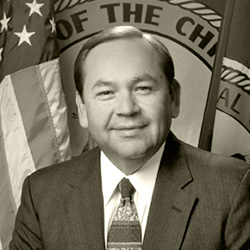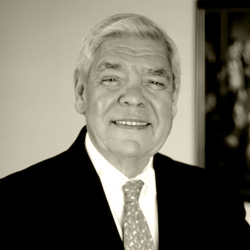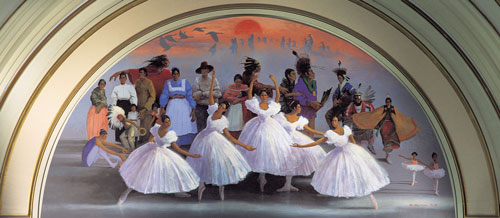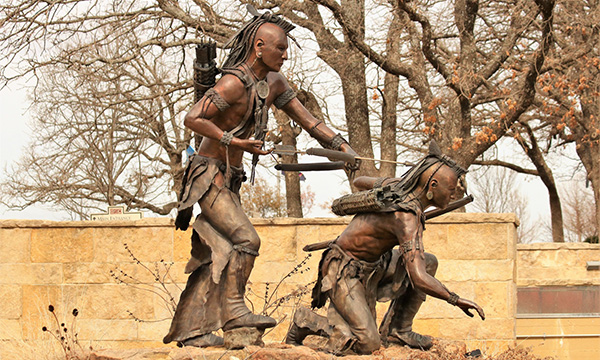The Chickasaw tribe of Native Americans has a rich history and indelible culture that have shaped the very foundations of Oklahoma, its history, and its people.
But to truly understand the lasting legacy and impact of the Chickasaw Nation, looking solely at their history isn’t enough.
Together, let’s explore the origins of the Chickasaw Nation, significant events in the history of their people, and examine how their history and culture continue to shape Oklahoma and its people to this day.
“They wanted the resources, they needed the land for expansion, and basically, forced us out of our homeland.”
— Bill Anoatubby, Chickasaw Nation Governor
Chapter 15
Where Did the Chickasaw Native Americans Originally Live?
The Chickasaw originally hail from the southeastern regions of the United States, particularly northwestern Alabama, western Tennessee, southwestern Kentucky, and northern Mississippi. Here, the Chickasaw lived in sophisticated cities and towns with robust trade systems and developed a rich culture that was — and still is — reverent of nature and community.
A strong people, the Chickasaw were known for their fierce protection of their kin and neighbors, becoming known as the “Spartans of the Lower Mississippi Valley” following their first contact with Europeans in 1540. Though the Chickasaw drove off Hernando de Soto and his throng of conquistadors, this first encounter marked the beginning of a great change in the region as Europeans encroached upon the land and furthered their territorial expansion.
Though often tenuous, beneficial trade relationships between the Chickasaw people and the Europeans were forged over time, with each bartering for goods, medicines, food, and other resources they couldn’t supply themselves.
These relationships and treaties, however, were ultimately met with disrespect by the Europeans as the United States began to expand, finally culminating in the forceful and unjust removal of the Chickasaw and other Native American tribes from their homes following the ratification of the Indian Removal Act by Congress on May 28th, 1830.
This violent upheaval forced the Chickasaw from their ancestral homelands, and set them upon a perilous journey, known as “The Trail of Tears,” to lands that the U.S. government had deemed reserved for the uprooted native people.
“But the Chickasaws, they didn’t swap land, they actually sold their land at public auction in Mississippi, and came west with a sack full of money. Because they wanted a separate government. They bought the western portion of the Choctaw Nation and again established their own sovereign government.”
— Neal McCaleb, State Legislator & Chickasaw Nation, DOT
Chapter 3
What Was The Great Removal and How Did it Affect the People of the Chickasaw Nation?
As European colonizers continued to flood inward, settling deeper and deeper within the southern United States, many sought to claim the lands inhabited by Native Americans like the Chickasaw.
While met with resistance by the Native people, colonizers who wanted their land used political chicanery, false treaties, manipulation, and even violence to forcefully remove the Chickasaw from their lands.
This desire to claim Native lands ultimately culminated in the aforementioned Indian Removal Act of 1830, which gave the Chickasaw and other Native Americans a ghastly ultimatum: abandon their way of life to assimilate into European culture or withdraw to Oklahoma territories.
Thus began the “Great Removal” of the Chickasaw people.
Regarded as the most painful chapter in the history of the Chickasaw Nation, the Chickasaw were set on a trek fraught with death, disease, and despair — The Trail of Tears.
Though thousands of Native Americans lost their lives on the arduous journey, the leaders of the Chickasaw Nation were wise and skilled negotiators which allowed them to fund their own journey, choose more favorable seasons in which to travel, and ultimately save countless lives by avoiding the harsher conditions that claimed so many.
Where Do The Chickasaw Native Americans Live Now?
Today, the Chickasaw people are known collectively as The Chickasaw Nation, the 13th largest federally-recognized tribe in the United States. The Chickasaw Nation’s territory is comprised of 13 counties within Oklahoma, totaling 7,648 square miles, encompassing the majority of the lands within the following counties:
Bryan County
Carter County
Coal County
Garvin County
Grady County
Jefferson County
Johnston County
Love County
Marshall County
McClain County
Murray County
Pontotoc County
Stephens County
Together, these lands serve as the boundaries of the sovereign nation of the Chickasaw and are home to the majority of its people.
“... not a lot of Chickasaw-speakers still around. But Governor Anoatubby and their Cultural Division is trying to reestablish the Chickasaw language as a part of the culture of the people.”
— Neal McCaleb, State Legislator & Chickasaw Nation, DOT
Chapter 4
What is the Native Language of the Chickasaw Nation?
The Chickasaw language is known simply as Chickasaw. Chickasaw is what’s known as a Muskogean Language, which is a family of languages spoken by native peoples throughout the southeastern United States.
Muskogean languages are typically divided into two distinct branches — Western Muskogean and Eastern Muskogean — and encompass 6 Native American languages that are still spoken to this day:
Western Muskogean Native American Languages
Chickasaw
Choctaw
Eastern Muskogean Native American Languages
Creek-Seminole
Hitchiti-Mikasuki
Apalachee-Alabama-Koasati
All of the Muskogean languages, including Chickasaw, are highly endangered languages, meaning they’re at high risk of becoming extinct and lost forever unless there are dedicated people who are willing to teach others the language and continue to teach Chickasaw to future generations.
As of the time of this writing, there are only 50 to 75 Native fluent speakers of the Chickasaw language, according to the Chickasaw Nation Department of the Chickasaw Language.
While endangered, the Chickasaw Nation is dedicated to ensuring their language and, in turn, culture, continue to thrive in the next generation and beyond through the Chickasaw Language Revitalization Program and similar initiatives.
“The Chickasaw beliefs — you can see a lot of similarity to that and to the beliefs of greater society ...”
— Bill Anoatubby, Chickasaw Nation Governor
Chapter 16
The Religions and Spirituality of the Chickasaw Nation and Their Impact on Oklahoma
The Chickasaw have always been a people rooted in spirituality, with no records of their people ever being without a belief in a higher power, whom they call Aba’ Binni’li’ (Dwelling Above). Under the influence of Christianity in the 1800s and onward, the name Inki Abu (Father Above) was also used.
From this, the core of Chickasaw spirituality and faith were focused on the 4 “Beloved Things Above:”
The Clouds
The Sun
The Clear Sky
Aba’ Binni’li’ / Inki Abu (He that lives in the clear sky)
This supreme deity represented all that was good. Living above the clouds and residing in the element of holy fire, Aba’ Binni’li’ was the creator of light, warmth, and all life. This belief led to a powerful reverence for fire, its use, and even how it was extinguished.
Today, the Chickasaw people come from a wide range of religious backgrounds and belief systems. However, the reverence for nature and compassion for one’s fellow man that was foundational to their way of life is still present within the Chickasaw Nation and can be felt within the communities — both Native and non-native — that they support.
The Foods of the Chickasaw Nation and Their Impact on Oklahoma
Withstanding the test of time and acting as a vessel of love and community, food is a cornerstone of any people and its culture, and the same can be said for the Chickasaw Nation.
While many dishes and foods were vital to the Chickasaw way of life, family, and society, these represent some of the historical staples and more well-known dishes that had a powerful effect on Oklahoma agriculture and cuisine.
Corn
If there’s one food that can be considered the staple food of the Chickasaw people, it’s corn. Having developed planting techniques and care methods that allowed their corn crops to yield bountiful harvests, the Chickasaw Nation stored, preserved, and used corn year-round and incorporated it into every aspect of their diets.
Three Sisters Stew
The three sister crops — corn, squash, and beans — are often planted together due to the uniquely symbiotic relationship each crop enjoys when grown in close proximity to one another. These crops and their ability to innately care for one another also served as a powerful cultural reminder for the Chickasaw people and the importance of looking after one another as a means of creating greater abundance for all.
With these crops being a constant factor in both seedtime and harvest, a wide variety of dishes sprang from their abundance, with none being more famous (or filling) than the Chickasaw Nation’s Three Sisters Stew.
Grape Dumplings
With the scientific name of Ampelopsis cordata, better known as possum grapes or raccoon grapes, these grapes are the heart and soul of the traditional Chickasaw dish of grape dumplings.
Though a relatively uncomplicated dish consisting of simple dumplings boiled in the juice of the possum grapes, it’s packed with flavor and a favorite of Native and non-native people throughout Oklahoma.
Pashofa
A traditional dish of the Chickasaw, it consists of hominy (cracked corn) and pork that is covered in water and boiled for hours. This dish was such a dietary staple that a pashofa pot was a staple item in almost every Chickasaw household. Hearty, warm, and with plenty of protein and carbohydrates to keep any Oklahoman fueled for the better part of even the hardest work day, pashofa is enjoyed year round to this very day.
The dishes of the Chickasaw people were those which inspired communion with one another, that made the household warm and inviting, and which kept people nourished — physically, emotionally, and spiritually — throughout the year.
Just as they did so for the Chickasaw then, they continue to do so now — for Chickasaw and non-native Oklahomans alike.
The Art of the Chickasaw Nation its Impact on Oklahoma
Art is the great communicator of any culture. Artists, like those in the Chickasaw Nation, break down the barriers of language, lineage, and time to reach the hearts and minds of those experiencing their work.
In Oklahoma, the artistry of the Chickasaw speaks to the past, present, and future of Oklahoma through a myriad of media and artforms, including:
Potters and weavers
Painters and Illustrators
Metalworkers and jewelers
Sculptors
Fashion designers
Singers and dancers
Actors
Musicians and composers
Through these artforms, the Chickasaw Nation not only continues to pass down its culture, stories, and traditions to the next generations of its own people, but also enriches the lives of Oklahomans throughout the state.
One of many perfect examples of the impact of Chickasaw artistry is the mural Flight of Spirit by the renowned Chickasaw artist Mike Larsen and which now resides in the Oklahoma State Capitol building.

The painting pays tribute to 5 world-renowned Native American ballet dancers from Oklahoma: Rosella Hightower, Yvonne Chouteau, Moscelyn Larkin, Maria Tallchief, and Marjorie Tallchief.
In the mural, we see the ballerinas symbolically intertwined with representations of their Native American heritage in Oklahoma, creating a powerful emotional contrast that ultimately blends together to create a forward-thinking message of unity and the importance of art while giving proper reverence to Native history.
In describing the meaning of his work, Larsen states, “This painting is about our heritage. It is a symbolic representation not only of the accomplishments of these ladies, but also of the essence of our lives conveyed through the arts.”
Through this and countless other masterful works of art, the creativity and artistry of the Chickasaw people is a continual source of inspiration for people throughout the state.
“And be your brother’s keeper. Work with others and make sure that if you can be of help and can be someone to be a leader of the group to step up and do it.”
— Bill Anoatubby, Chickasaw Nation Governor
Chapter 16
The Impact of the Chickasaw Nation on the History of Oklahoma
Simply put, the history of the Chickasaw Nation is the bedrock of the history of Oklahoma.
Chickasaw art channels the heart and courage of their people and celebrates the beauty of Oklahoma and its natural wonders. Their food links the past with the present, bringing comfort and compassion to their families, friends, and neighbors. And their culture and society is what all Oklahomans should strive toward: an unconditional love for family, the land, and one another.
While we’ve covered a great deal of the history of the Chickasaw Nation and its impact on the state of Oklahoma, there is always more to learn and more stories to tell. For more information about the Chickasaw Nation, visit the Chickasaw Nation’s official website and their other historical and cultural resources at:
Educational content like this and our ever-growing collection of oral histories from influential Oklahomans is only made possible by gifts from readers like you. A gift of any amount helps us continue our mission to preserve, protect, and share the voices and stories of Oklahoma’s people and history.


